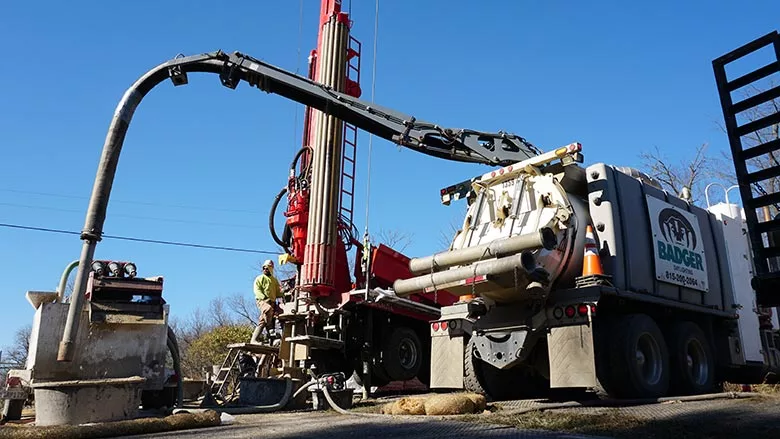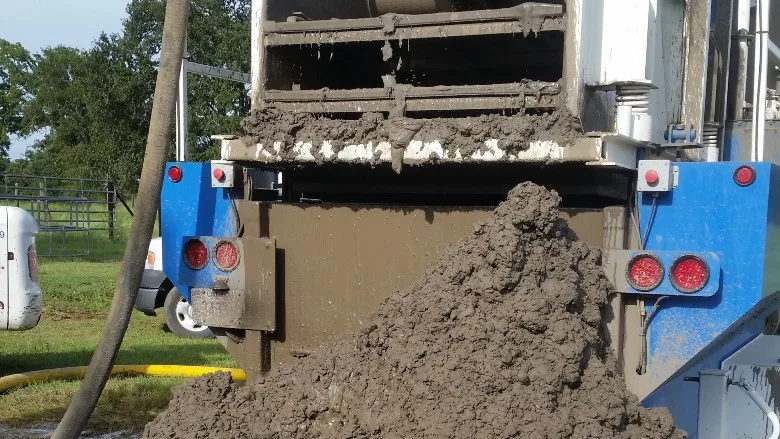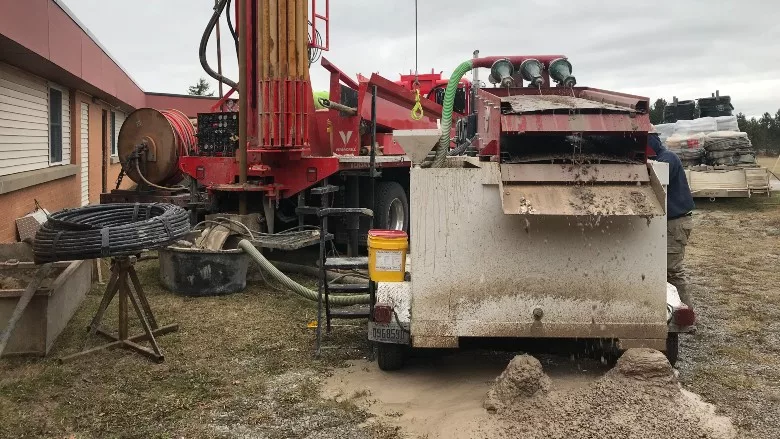Tips for Fast, Efficient Production Drilling
Effective Materials Handling Plan Helps Operators Drill Faster

High-production drillers come to each project with an effective materials handling plan. What happens to everything that comes out of the hole?
Source: Brock Yordy

Operators can increase both production and efficiency (and save some shoveling) with a mechanical solids unit. Solids units also allow operators to reduce their circulating hole volume.
Source: Brock Yordy

Materials volumes, of course, go up with hole depth and diameter.
Source: Brock Yordy
The geothermal revolution is happening right now, from the 24 governors who make up the U.S climate alliance to the recent state and federal laws helping us get to “net zero” by 2050. The big question in this revolution is, how will all these holes get drilled?
The State of New York has a plan to transition 2 million homes to geothermal in the next 5 years. Let’s estimate one rig could drill three homes a week and operate 48 weeks a year. New York would need more than 2,700 rigs and drillers to complete its goal, and it is just one of many states looking to ramp up geothermal production to meet net-zero goals. Clearly, in addition to recruiting more drillers and building more rigs, we all must drill faster and more efficiently to meet this demand.
Suddenly, I hear my favorite line from a Mel Brooks movie: “Prepare ship for ludicrous speed!”
To increase drilling speed and efficiency, we first have to build the capacity to move material faster. Efficiency starts with identifying the density of the geology and the expected cubic feet of material per rod according to the borehole specifications.
Next, maximum penetration rate depends on pump or compressor volume and pressure capabilities. The standard reference is 150 feet per minute uphole velocity for mud and 3,500 feet per minute for air. That pumping action must move cuttings up the hole effectively while not causing instability to downhole formations. Dense formations can withstand greater pressure than fragile, porous formations. You want to drill fast while maintaining a stabilized borehole so that a loop can be installed to final depth and fully grouted.
After understanding the pumping action, we can identify the bit and tooling required to maximize penetration rate. A steady, straight penetration rate requires the proper bottom hole assembly to keep the hole straight and gauge. Appropriate weight on the bit and correct jetting action maximize cutting action and bit life.
Finally, a suitable drilling fluids program minimizes impact on porous formations, preventing destabilization and collapse.
Let’s look at an easy example borehole: 6-inch diameter borehole with a total depth of 400 feet in a sand and gravel geology.
What hampers your production? Did you say, “Nothing”? Or maybe, “Drilling sand and gravel are easy, Brock, and it’s time to blow and go.” The right tooling and fluids cannot help you succeed without a plan for how to handle 3.9 cubic feet of cuttings created per rod, likely every three to five minutes. A 6-inch bit creates at least 1.47 gallons of cutting per foot, 3.9 cubic feet per rod and 2.9 cubic yards of material for the entire example hole. That math assumes a gauge 6-inch hole to 400 feet. However, we all know how disruptive downhole a “blow and go” approach can be. An efficient, prepared driller would expect at least 2.9 cubic yards of material. How we manage drill solids directly impacts the rate of penetration.
In our example, one rod creates roughly a wheelbarrow full of solids. We have two options for handling solids: physical or mechanical solids control. In physical solids control, the driller assistant shovels cuttings out of the pan. They would move roughly 20 wheelbarrows of material in the time it takes to drill the hole. In mechanical solids control, cuttings transfer from the mud pan to a mechanical unit made of shakers and cones. Both methods, when utilized properly, can succeed. However, a mechanical unit does not require rest (or complain about moving 60 or more wheelbarrows of material in a shift).
A standard 250-gallon mud pan becomes 30% solids or greater before you reach 200 feet due to the number of solids recirculating. Not even the best assistant driller can out-shovel physics.
In solids handling, I find operators often overlook that to increase production you have to circulate larger volumes of drilling fluids. The problem starts with believing that drilling faster requires more pump output. Faster drilling requires the correct pump output to control the disruption. To maintain a 150-feet-per-minute uphole velocity in a 6-inch hole, mud pump output is only 122 gallons per minute. Consider how quickly the fluid recirculates downhole. A standard 250-gallon mud pan becomes 30% solids or greater before you reach 200 feet due to the number of solids recirculating through the pump, shear points in the top head and jets at the bit. Not even the best assistant driller can out-shovel physics. For that reason, drilling fluid fundamentals require a circulating volume of two and half times the hole volume. In our example borehole, we would want about 1,470 gallons (1.47 gallons per foot for 400 feet times 2.5). If your mud pan has a volume of about eight wheelbarrows, how long before you start recirculating solids? A circulating volume 2.5 times the hole volume allows time to remove solids before drilling fluids becoming overloaded.
Just so we don’t blame our overworked assistant for not shoveling fast enough, the same situation can happen with a poor mechanical solids control program. For example, we have a 500-gallon volume system with a 100-gallon pit at the back of the rig. Our example borehole has a volume of 588 gallons. The drilling process requires volume to drill and the mechanical unit requires a working volume to remove solids. If the rig pumps 250 gallons per minute, the solids control unit must have at a minimum 250 gallons per minute in recirculating capacity. In this case, a solids control unit only requires a circulating volume about 1.5 times the hole volume. Our example borehole using mechanical solids control would only need a circulating volume of about 882 gallons (1.47 gallons per foot for 400 feet times 1.5).
The final piece to drilling faster? Understanding how much waste we generate by the end of a single borehole. In our example borehole, it starts with 2.9 cubic yards and is compounded with an additional volume of 1.5 to 2.5 times the hole volume. We can easily create 5 to 7 cubic yards of waste drilling three to four holes daily. That would load up two dump trucks or vacuum truck with waste.
Drilling generates waste that requires proper disposal. Create a plan for managing the drilling fluid phase that allows recycling a portion for the next hole as low-solids drilling fluids. Handle the rest of the waste in a manner that creates dry solids ready for disposal in a dump truck. Taking on a large drilling project identifies you as a co-generator of specialized waste. When that specialized waste is contaminated with unknown factors downhole it can become hazardous waste, with all the responsibilities that come with that distinction. However, with proper understanding and execution, we can reduce the waste generated and reuse the drilling fluid and water generated.
Next month, I will outline an effective plan from start to finish to minimize disposal.
Looking for a reprint of this article?
From high-res PDFs to custom plaques, order your copy today!





